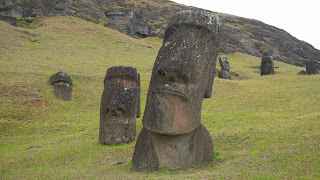Studies of history claims there once lived as many as 15.000 people on the island, but the huge settlement led to deforestation and depletion of natural resources, reducing the population to at least one third before it was discovered by the Europeans. They again managed to further reduce this down to just 111 by 1877. When the island came under Chilean administration in 1888 they decided to run it as a sheep farm, confining the 111 indigineous Rapa Nui to the area of Hanga Roa which is the main city of the island.
It wasn't until 1960 they regained access to the rest of the island and the sheep were taken away. Luckily, island life seems to be thriving and according to the 2012 census, Rapa Nui now has 5.800 inhabitants of which some 60% are decendants of the indigenous people. The people in the island are proud of their heritage and very interested in speaking to visiting foreigners and tell them about the island. We caught a show performed by a local dance group showing us some traditional dances:
We had three days to explore the Island. The first one was spent mainly around Hanga Roa, shopping for souvenirs and getting to know our way around the local area. As this village is the only somewhat dense populated area of the Island, navigating by foot became the prefered way of doing things. There are in total 2 ATMs on the Island, quite a few restaurants, and some tiny, charming "supermercados". And of course, everywhere there are souvenir shops - and dogs roaming the streets. :-)
The second day we booked a tour with our french hostess Morgana, who is a resident of the Island on her 7th year now. The number one sight on Rapa Nui is ofcourse the "moai" - the giant statues - that are spread all over the place in a number totalling almost 900. The biggest one that was never finished is as tall as 22 meters and would weigh approximately 1880 tons. Just HOW did the Rapa Nui manage to move these colossal things from the mountain where they were carved to the platforms they were erected? Noone knows for sure even to this date, though several theories are in place.
Morgana drove us west, to Rano Raraku - the volcano which was the "factory" for production of the moai. She told us about the history of the Island - about the "Long ears" and the "Short ears" - and the civil war. In the early days there were many tribes of the island, and each tribe had a system where there was a small group of nobles (long ears), and a large amount of servants (short ears). Apparently the short ears got fed up with making the statues for the long ears and started a riot, killing their masters and pushing most of the statues over, making them fall flat on their faces.
These days there are hundreds of archeological sites spread around the island, learning more and more about life in the early days. However, the very first expedition was led by none less than famous Norwegian Thor Heyerdahl back in 1955-56! Amongst other things his expedition erected one of the fallen statues which is still there today around Anakena beach on the north side of the island. We visited this moai too and it is well documented on our cameras. :-)
The second day we drove to the west side of the island, and the area of "Oronga" - home to the ritual of the cult of the bird men. The "Tangata manu" (bird-man) were chosen for one year at a time after winning a race in the annual ritual. The contestants would jump from a cliff, swim out to the small island of Motu Nui, collect an egg, and return it to shore. After winning, the Tangata manu was sacred for a period of 5 months and his tribe the first to harvest the years supply of bird eggs. The origin of the religion of tangata manu is uncertain, but it was wiped out by christian missionaries in the 1860s. Cave paintings, carvings and the islands itself still stand though and was worth a visit:
Morgana told us she fell in love with the island on her first visit, making her return for a proglonged stay of what was supposed to be 2-3 months. By now those few months have grown into 7 years and it doesn't look like she'll be leaving anytime soon.
For me I think the island life would be a little too simple. The island is to small to explore for a prolonged amount of time, and I guess I would grow restless pretty soon. That being said I absolutely recommend a visit to Rapa Nui as it was a beautiful and exotic place. You're good with 3 days to explore the sights, but add a week if you also like to do some diving which is said to be excellent here. We didn't have the time to try it out, but you'll never know. Maybe some day I too will return on my way to, let's say, Pitcairn Island!






Ingen kommentarer:
Legg inn en kommentar